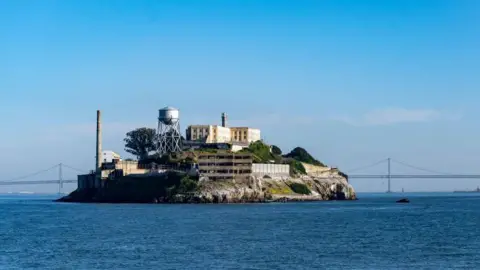In a surprising turn of events, former President Donald Trump has announced his directive to reopen Alcatraz, the infamous former prison located on an island off the coast of California. This significant announcement came in a post on his Truth Social platform, where Trump articulated his discontent with what he perceives as a crisis stemming from violent offenders operating freely in America. He stated that the reopening of Alcatraz would not only serve to “house America’s most ruthless and violent offenders” but will also stand as a “symbol of law, order, and justice.”
Trump’s message triggers a significant historical and cultural reflection. The original Alcatraz prison was closed back in 1963, with the island now functioning predominantly as a tourist destination. It is situated near the iconic Golden Gate Bridge in San Francisco, drawing countless visitors each year who come to learn about its notorious past. The prison’s structure, coupled with its storied history, makes it a deeply fascinating subject within discussions surrounding crime and punishment in the United States.
In his proclamation, Trump mentioned that the reopening plan would involve the Bureau of Prisons working closely with the Department of Justice, FBI, and Homeland Security to undertake a substantial reconstruction of the facility. The intent is to create an expanded prison capable of accommodating the most dangerous criminals. This initiative seems to be in part a response to Trump’s previous confrontations with the judiciary over his controversial policies concerning crime and immigration.
Notably, Trump has previously clashed with courts regarding his attempts to transfer alleged gang members to foreign prisons, including a move earlier this year that saw over 200 Venezuelan gang members sent to a facility in El Salvador. His talk of sending “homegrown criminals” to international detention centers has drawn both criticism and support, reflecting the divisive views on prison and punishment in contemporary America.
Historically, Alcatraz was not always known as a prison for the worst offenders. Initially constructed as a military fort, it was repurposed as a military prison in the early 20th century. By the 1930s, the site became commandeered by the Department of Justice and began taking inmates from federal institutions. It housed notorious criminals such as Al Capone, Mickey Cohen, and George “Machine Gun” Kelly, lending credibility to its reputation as a maximum-security facility.
The infamous institution gained fame not only due to its high-profile inmates but also through popular culture. The prison was immortalized in the 1962 film “Birdman of Alcatraz,” starring Burt Lancaster. This film tells the story of convicted murderer Robert Stroud, who while serving time at Alcatraz went on to become an ornithologist. Similarly, the 1996 action film “The Rock,” featuring mega-stars Sean Connery and Nicolas Cage, further solidified Alcatraz’s place in cinematic history, contributing to its mystique and allure.
Despite its historical significance, Alcatraz’s operations were halted primarily due to its high costs. The Federal Bureau of Prisons reported that maintaining the prison was nearly three times more expensive than running other federal facilities, largely due to its isolated geographical location.
As Trump calls for Alcatraz to be rejuvenated and transformed into a functional prison facility once again, the move raises numerous questions about the implications for America’s justice system. It presents an opportunity for nuanced discussions on crime management, rehabilitation versus punishment, and the role of historical prisons in contemporary society. The plans for Alcatraz could serve as a catalyst for broader conversations surrounding criminal justice reform in America moving forward.



